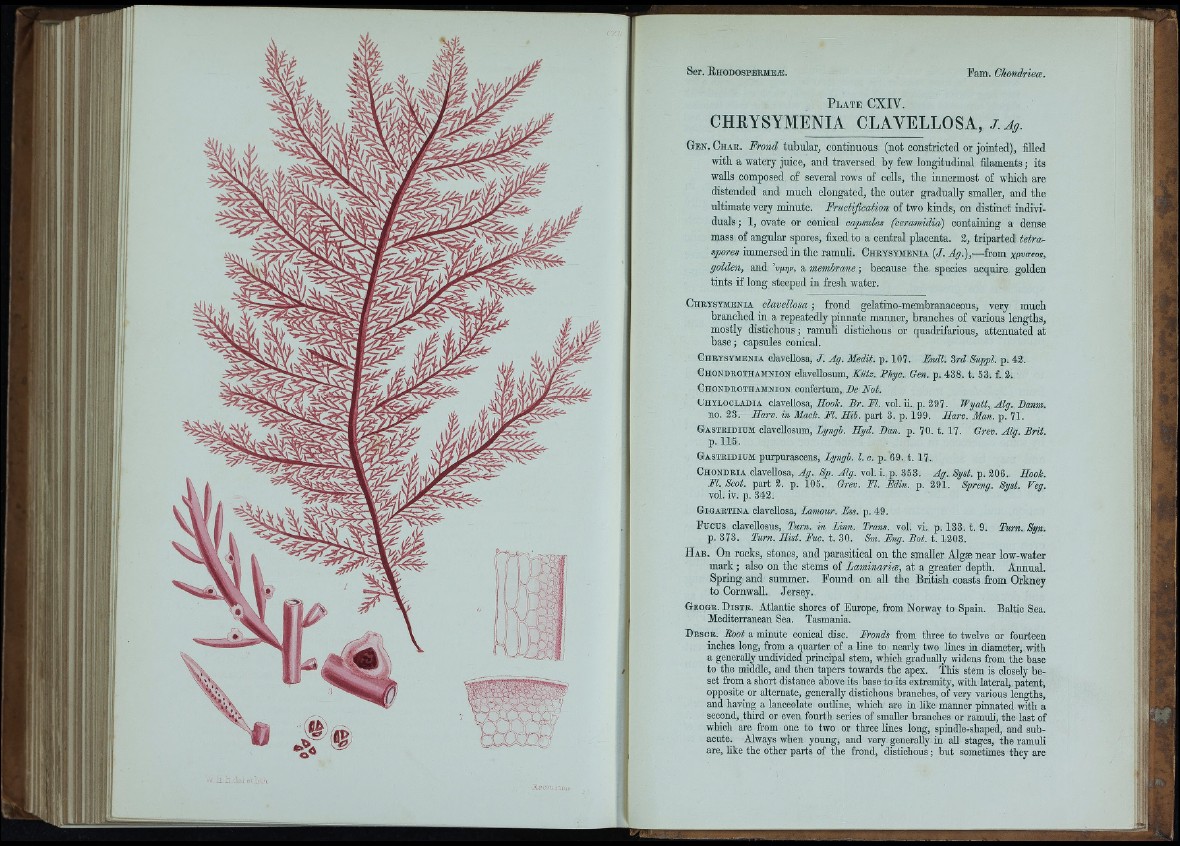
P l a t e CXIV.
CHRYSYMENIA CLAVELLOSA,/.^y.
Gen . C h a r . Frond tubular, continuous (not constricted or jointed), filled
witb a watery juice, and traversed by few longitudinal filaments ; its
walls composed of several rows of cells, tbe innermost of wbicb are
distended and mucb elongated, tbe outer gradually smaUer, and tbe
ultimate very minute. Fructification of two kinds, on distinct individuals;
1, ovate or conical capsules (ceramidia) containing a dense
mass of angular spores, fixed to a central placenta. 2, triparted tetra-
) immersed in tbe ramuli. C h ey sym en ia (/. Ag),-—from xpvaeos,
and ’vprjv, a membrane ; because tbe species acquire golden
tints if long steeped in fresb water.
C h ey sym en ia clavellosa ; frond gelatino-membranaceous, very much
branched in a repeatedly pinnate manner, branches of various lengths,
mostly distichous ; ramuli distichous or quadrifarious, attenuated at
base; capsules conical.
C h b tsym e n ia clavellosa, / . J g . Medit. p. 107. Etidl. 3rd Suppl. p. 4 3 .
C h o n d ro th am n io n clav ello sum, Kütz. Fhyc. Oen. p . 4 3 8 . t. 5 3 . f. 2.
Chondrothamnion confertum. Be Not.
Chylooladia clavellosa. Hook. Br. M. vol. ü. p. 297. Wyatt, Alg. Banm.
no. 23. Harv. in Mack. M. Hih. part 3. p. 199. Harv. Man. p. 71.
Gastridium claveUosum, Lyngh. Hyd. Ban, p. 70. t. 17. Grev. Alg. Brit.
p. 115.
Gastridium purpurascens, Lyngh. I. c. p. 69. t. 17.
C h o n d r ia clavellosa, Ag. Sp. Alg. vol. i. p . 3 5 3 . Ag. Syst. p . 3 0 6 . Hook.
M. Scot. p a r t 2. p . 1 0 5 . Orev. FI. Fdin. p . 291. Sprmg. Syst. Veg.
vol. iv . p . 3 4 2 .
G ig a e t in a clavellosa, Lamour. Fss. p . 4 9 .
Fuous clavellosus. Turn, in LAnn. Trans, vol. vi. p. 133. t. 9. Turn. Syn.
p. 373. Turn. Hist. Fuc. t. 30. Sm. Fng. Bot. 1 .1203.
H a b . On rocks, stones, and parasitical on the smaller Algæ near low-water
mark ; also on the stems of Laminaria, at a greater depth. Annual.
Spring and summer. Found on aU the British coasts from Orkney
to CornwaU. Jersey.
G eogr. D istr. Atlantic shores of Europe, from Norway to Spain. Baltic Sea.
Mediterranean Sea. Tasmania.
Desoe. Boot a minute conical disc. Fronds from three to twelve or fourteen
inches long, from a quarter of a line to nearly two Hnes in diameter, with
a generally undivided principal stem, which gradually widens from the base
to the middle, and then tapers towards the apex. This stem is closely beset
from a short distance above its base to its extremity, with lateral, patent,
opposite or alternate, generally distichous branches, of very various lengths,
and having a lanceolate outline, which are in like manner pinnated with a
second, third or even fourth series of smaller branches or ramuH, the last of
which are from one to two or three lines long, spindle-shaped, and subacute.
Always when young, and very generally in aU stages, the ramuli
are, Hke the other parts of the frond, distichous ; but sometimes they are